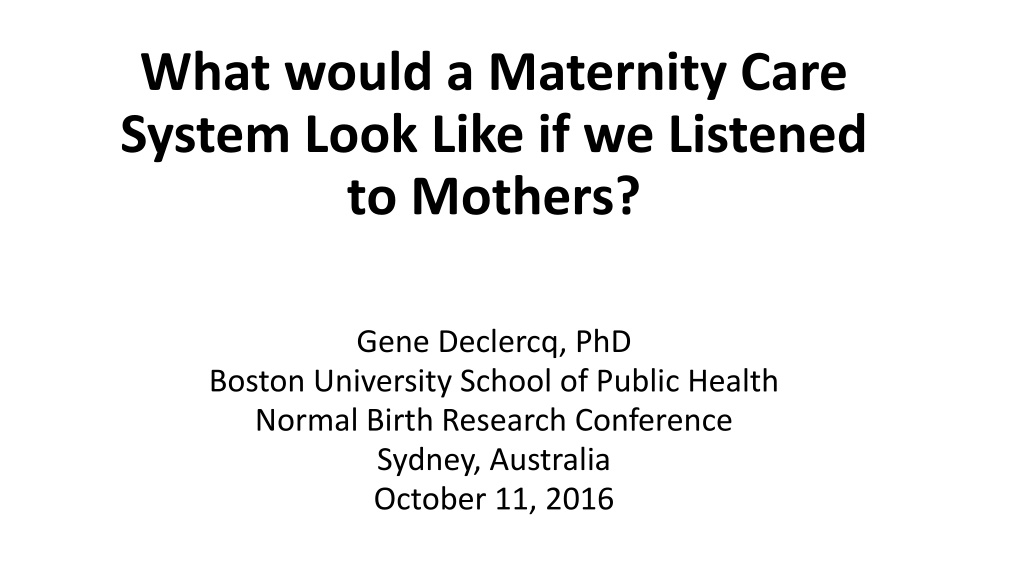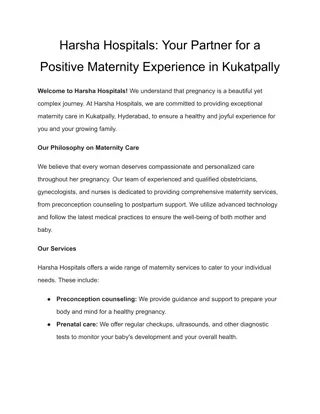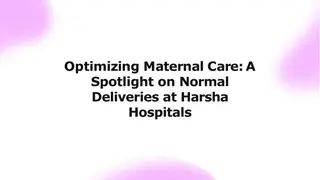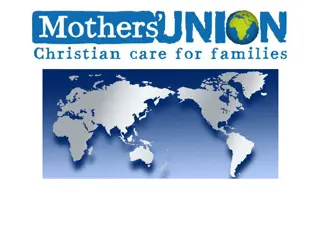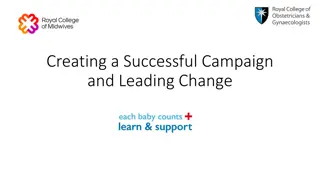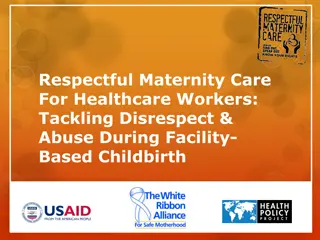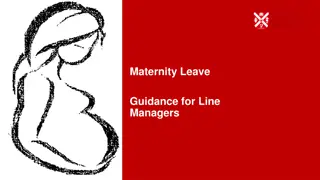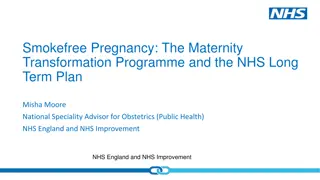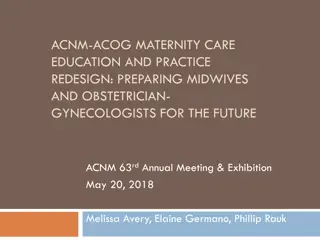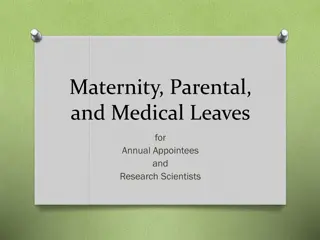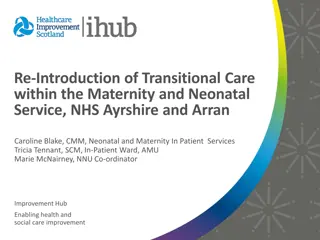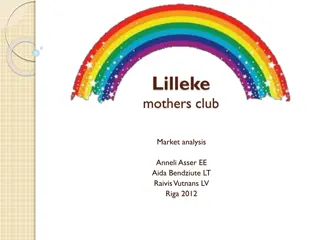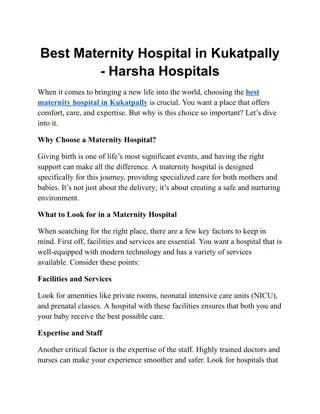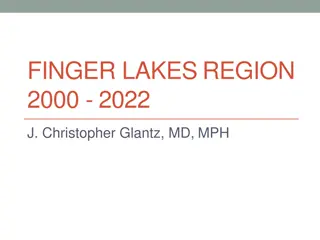Maternity Care Systems Through Mothers' Perspectives
An insightful presentation by Gene Declercq, PhD, at the Normal Birth Research Conference in Sydney, Australia, discussing the ideal maternity care system when informed by the experiences and feedback of mothers. Dr. Declercq will integrate existing data to explore how such a system can better cater to the unique needs of mothers during childbirth and beyond.
Download Presentation

Please find below an Image/Link to download the presentation.
The content on the website is provided AS IS for your information and personal use only. It may not be sold, licensed, or shared on other websites without obtaining consent from the author. Download presentation by click this link. If you encounter any issues during the download, it is possible that the publisher has removed the file from their server.
E N D
Presentation Transcript
What would a Maternity Care System Look Like if we Listened to Mothers? Gene Declercq, PhD Boston University School of Public Health Normal Birth Research Conference Sydney, Australia October 11, 2016
Presentation will involve both existing data and material from unpublished studies. Slides not involving unpublished data will be posted and available to download for free at: www.birthbythenumbers.org Please do not take pictures of the data slides!
Putting the U.S. and Australia in Comparative Context (Caution: Measures are not always consistent between countries or over time)
Female Life Expectancy, U.S. and Australia, 1960-2014 85 80 75 Australia U.S. 70 65 BirthByTheNumbers.org Source: OECD Health Data 2016
Infant Mortality (per 1,000 live births), U.S. and Australia, 1960-2014 30 25 20 Australia U.S. 15 10 5 0 BirthByTheNumbers.org Source: OECD Health Data 2016
Perinatal Mortality(per 1,000 live births), U.S. and Australia, 1960-2014 30 25 Australia U.S. 20 15 10 5 0 BirthByTheNumbers.org Source: OECD Health Data 2016
Maternal Mortality Ratio (per 100,000 live births), U.S. and Australia, 1960-2014 60 50 40 Australia U.S. 30 20 10 0 BirthByTheNumbers.org Source: OECD Health Data 2016
Maternal Mortality: Maternal Mortality Rates (per 100,000 live births) U.S. and Australia, 2000-2014 25 20 This is the what increasing U.S. maternal mortality but we need to dig deeper to know why Australia U.S. 15 10 5 0 2000 2001 2002 2003 2004 2005 2006 2007 2008 2009 2010 2011 2012 BirthByTheNumbers.org 2013 2014 Source: OECD Health Data 2016; Macdorman .OBGYN, 2016.
U.S. & Australian MMR* Compared to Countries with 300,000+ births, 2014, using WHO Estimates Italy 4 Spain 5 Japan 5 Australia 6 Germany 6 Canada 7 France 8 U.K. 9 Korea 11 U.S. 14 0 2 4 6 8 10 12 14 16 * Maternal Mortality per 100,000 births Source: Maternal Mortality: 1990 to 2015 Estimates by WHO, UNICEF, UNFPA, World Bank Group & UN Population Division. Geneva: 2015.
Female Overweight and Obesity, 2013 66.1% 70% 56.2% 60% Overweight 50% 36.6% 28.2% 40% Obese 30% 20% 29.5% 28.0% 10% 0% Australia U.S. BirthByTheNumbers.org Source: OECD Health Data 2016
Female 15+ Daily Smokers, 2013 25% 20% 15% 11.9% 11.3% 10% 5% 0% Australia U.S. BirthByTheNumbers.org Source: OECD Health Data 2016
Why Its Important to Listen to Mothers
Humblingbecause we find that they dont think like we do Maternal Attitudes Determine mothers attitudes toward pregnancy, birth and the postpartum experience Mothers Perspectives Document mothers experience from their perspective Identify needs and who has them that wouldn t be known from other data sources Can get at the Why? question which is not possible from other sources which focus on What? Leads to better Designof Systems and better Outcomes BirthByTheNumbers.org
So what can we learn from mothers that we can t learn from other sources? BirthByTheNumbers.org
Lets go back a century for an example of the limits of using only secondary data
Problem with an exclusive focus on quantitative data? Case of Birth Certificate Data Sept. 22, 1914
1985 1985 1994
Birth Certificate Data 1914 MA Birth Certificate
But then another possible source of data turned up that could provide new insights
Birth Certificate Data Canvass of Births in City 1914 MA Birth Certificate
Birth Certificate Data Canvass of Births in City 1914 MA Birth Certificate
Genes Brilliant Historical Data Analysis Lopiano Pedrazzini Calitri Riopelle Calitri Pedrazzini Stella Carbonaro Scarito Barbieri DeMarco Then I listened to someone this was completely wrong
So if listening to mothers provides new insights, who does it?
National Surveys of Mothers Concerning Maternity Experiences Canada What Mothers Say: The Canadian Maternity Experiences Survey. 10/23/06-1/31/07. Primarily phone Interviews 6,421 mothers in a singleton birth (78% response rate). England Safely Delivered. 2014. 4/2014-6/14. Postal Survey. 4,571 (47% response rate). Primarily mail surveys Australia .sort of.
Survey Data 2400 mothers 18-45 who had given birth to single babies in a U.S. hospital from July 1, 2011 through June 30, 2012 completed the 30 minute survey online in English. The data were adjusted with demographic and propensity score weightings using methodology developed and validated by Harris Interactive with results generally representative of U.S. mothers on age, race/ethnicity, parity, birth attendant and mode of birth. Mothers who completed the initial survey were recontacted and invited to complete a follow-up survey between January 29 and April 15, 2013. A total of 1072 mothers, or 45% of the initial participants, were reached and completed the survey.
So what would a Maternity Care System Look Like if we Listened to Mothers?
What would a Maternity Care System Look Like if we Listened to Mothers? 1. Careful, accurate prenatal diagnosis (The case of the Big Baby ) 2. Choice in the Place of Birth 3. Choice in Method of Delivery (The case of the vanishing VBAC)
What would a Maternity Care System Look Like if we Listened to Mothers? 4. Opportunity for Shared decision making (Induction and repeat cesareans) 5. Support for their method of infant feeding (Hospital support for breastfeeding) Bonus Material!
1. Careful, Accurate Prenatal Diagnosis I would like my maternity care provider to tell me about the risks associated with each option so I know how each could affect me. Strongly Agree 36% Agree 55% Disagree 7% Strongly Disagree 2% Source: Listening to Mothers 3
Labor Induction Three in ten (29%) mothers tried to start their labor on their own. More than four out of ten respondents (41%) indicated that their care provider tried to induce their labor Three out of four of those women (74%) indicating that it did start labor, resulting in an overall rate of medically induced labor of 30%.
Inductions in U.S., & Australia, 1990-2014 30% Australia 25% U.S. 20% 15% 10% 5% 0%
Reasons why mothers experienced medical induction Base: care provider tried to induce labor n=991 44% Baby was full term/close to due date 19% Mother wanted to get pregnancy over with 18% Care provider was concerned that mother was overdue 18% Maternal health problem that required quick delivery Care provider was concerned about the size of the baby 16% 12% Water had broken and there was a concern about infection 11% Mother wanted to control timing of birth for work or other personal reasons 11% Care provider was concerned that amniotic fluid around the baby was low 10% Care provider was concerned that baby was not doing well 10% Mother wanted to give birth with a specific provider 10% Some other reason
Reasons for primary and repeat cesarean birth Base: had cesarean n=744 (choose reason that best applies)) Repeat cesarean n=376 Primary cesarean n=368 n.a. 61% I had had a prior cesarean (asked of prior cesarean only) 16% 3% Baby was in the wrong position 11% 3% Fetal monitor showed the baby was having problems during labor 10% 13% I had a health condition that called for procedure 10% 2% Baby was having trouble fitting through Maternity care provider worried the baby was too big 9% 2% Provider tried to induce labor but it didn t work 8% 3% 8% 2% Problem with the placenta 7% 2% Labor was taking too long Past my due date 3% - Afraid to labor and have baby vaginally 3% - No medical reason 4% 3%
Are U.S. Babies Getting Bigger?...NO! % Singleton, Full Term Babies by Birthweight, U. S., 1990-2014 3500-3999gms 4000+gms 50% 44% 44% 41% 39% 40% 38% 39% 30% 30% 32% 29% 30% 30% 32% 20% 10% 12% 11% 9% 9% 12% 9% 0% 1990 1995 2000 2005 2010 2014 www.BirthByTheNumbers.org Source: Centers for Disease Control and Prevention. National Center for Health Statistics. VitalStats. http://www.cdc.gov/nchs/vitalstats.htm. (Access 12/23/15)
Number of Ultrasounds None 2% 48% 4+ ultrasounds 1 8% 2 21% 3 22% 4 14% 68% of mothers had ultrasound for weight 5 11% 6 8% 7+ 15% 0% 5% 10% 15% 20% 25%
Whats with these Big Babies? Near the end of your pregnancy, did your maternity care provider tell you that your baby might be getting quite large? ALL Yes No 31.2% YES Actual Weight 7 lbs 5 ounces 7 lbs 7 lbs 1 ounce 14 ounces Baby Actually Macrosomic 9.9% 19.7% 5.5% (8lb 13ounces) Source: Cheng et al. Healthcare Utilization of Mothers with Suspected Large Babies. MCH Journal. 2015. 19:2578 2586
Whats the impact of being told you might have a big baby? Labor and Delivery Outcomes Suspected Large Baby Yes % 43.0 70.1 21.1 72.7 No % 24.7 51.1 18.1 61.7 Tried Self Induction of Labor Medical Induction of Labor Cesarean Delivery Epidural Analgesia Requested Cesarean Delivery *** *** NS *** 32.5 6.8 *** ***p < .001 46 BirthByTheNumbers.org Source: Cheng et al. MCH Journal. 2015. 19:2578 2586
Likelihood of Labor or Delivery Outcomes Controlling for Key Variables Self Induced Labor almost twice as likely Medical Induction almost twice as likely Epidural twice as likely Requesting a cesarean 4 times as likely 47 BirthByTheNumbers.org
Would have never discovered this phenomenon if we didn t listen to mothers
2. Mothers Interest in Alternatives for Place of Birth
Out of Hospital Birth Rates, Selected Countries, 1935-2010 100% 80% 60% Finland Japan 40% Netherlands U.S. 20% U.K. Germany 0% 1935 1938 1941 1944 1947 1950 1953 1956 1959 1962 1965 1968 1971 1974 1977 1980 1983 1986 1989 1992 1995 1998 2001 2004 2007 2010 Sources: National Vital Statistics and Birth Reports, various countries.
